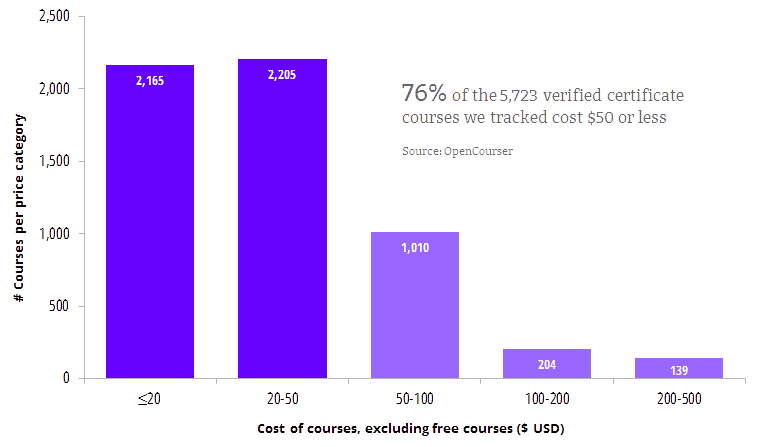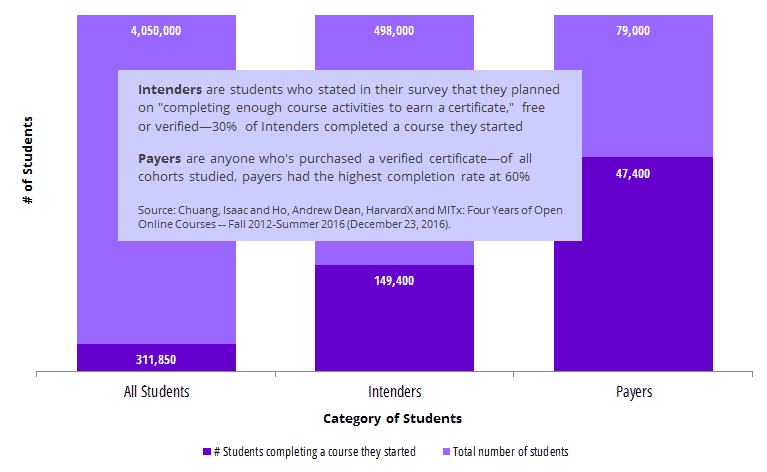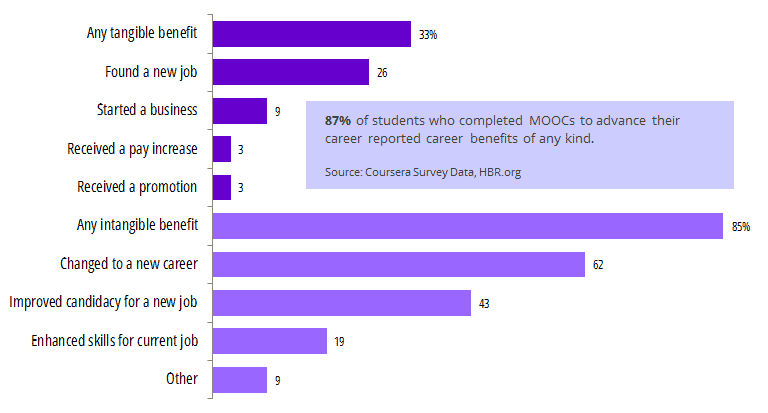
Paying for online courses isn't a new concept. Lynda, one of the largest sites for training videos, has charged learners for more than a decade. Even platforms for MOOCs (massively open online courses), which started out massively open because the courses they offered were free, have long offered paid "verified certificates."
Increasingly, however, MOOCs are beginning to put features like quizzes, homework assignments, exams, and entire lectures behind paywalls. The price for access? About $47 on average.
So much for massively open!

Yet, this cost is minuscule compared to what you'd pay in tuition to enroll in a university. Taking similar courses in a university or school would set you back as much as tens of thousands of dollars each year on tuition alone.
But just because something's inexpensive doesn't mean it isn't valuable.
We've come up with three situations when you might want to pay.
1) Pay when you absolutely must learn a skill or concept
I've often been asked what the value of buying a course certificate is. Aside from the obvious (receiving an official certificate and gaining access to locked course materials), there's plenty of intrinsic value in paying.
Students who paid for their online courses were 11 times more likely to complete them
Studies show that we're likely to value something we pay for more than we do that same something we receive for free. Ciadini's Influence: Science and Practice explores this psychological phenomenon in depth, but in short, we're more likely to take our online courses and MOOCs seriously if we have skin in the game.
Human minds are also susceptible to the sunk cost fallacy. We're likely to pour time, effort, and money into a course we've already spent time, effort, and money on until we extract enough value from it. While we'd normally want to catch ourselves before we fall prey to this fallacy, here we can use it to our advantage.
Here, paying helps us psych ourselves out to finish a course. Why? Because not finishing would cause us psychological pain that we naturally resist. It's easy to drop a free course willy nilly, but not so much for a paid one.
The numbers back this point.
 A recent study
A recent study(2017) published by MIT and Harvard found that only 7.7% of students completed a course they had started. That number increased to 30% for survey respondents who stated an interest in completing a course, and rose sharply to 60% for students who paid for a verified certificate.
This study echoed earlier figures published by edX in 2015, which found that students who paid for their online courses were 11 times more likely to complete them.
2) Pay when your ROI on learning is clear
We all have different motivations for learning. Sometimes we learn for fun or to satisfy a curiosity we have. Other times, we learn because there's something in it for us, to advance our career or make us more efficient and effective at our work.
Its under these circumstances where our return on investment (ROI) for learning is most quantifiable. If you take a course that makes you more knowledgeable about your field, more efficient at your work, or enables you to take on more responsibility, then you're suddenly more valuable to employers.

At the very least, you earn no monetary reward for your efforts, but your learning helps you take greater ownership of your career and professional life. In more optimal cases, learning a new skill or mastering new concepts will lead to raises, promotions, or new job opportunities—tangible benefits you can assign with a dollar value.
When the average cost of an online course is only $47, your returns could be many (hundreds, thousands even) multiples of your investment.
One Harvard Business Review study completed in 2015 in coordination with Coursera suggests as much. Authors of that article sent a survey to 780,000 people who had completed a MOOC.
Of those who responded, 52% cited career benefits as their primary motive for completing a MOOC. Among those "career builders," 33% reported having received tangible benefits (raises, new job, etc.) and 85% intangible benefits (e.g. improving skills at a current job or being better positioned to land a new job).
3) Pay because you want MOOCs to succeed in the long run
We're immensely fortunate to live in an era where education and information is so readily accessible.
MOOCs began as an experiment and exploded in popularity when leading universities joined in. Numerous studies have shown the positive impact these online courses have made on education and troves of anecdotal stories from learners show how MOOCs have changed lives.
There are, however, tremendous costs associated with providing MOOCs. Anant Agarwal, a professor who taught edX's first MOOC and who now serves as CEO of edX, cites first time course development costs ranging anywhere from $5,000 to $1 million, with typical courses costing about $50,000 to set up and run.
The money goes to funding a vast operation. Instructors often need to reshape their courses for an online audience, prepping new quizzes, exercises, exams, and lectures. Additionally, legions of staff must chip in to market courses, strike up new partnerships, provide support to students, and maintain the servers.
If a MOOC you're taking has changed the way you think about the world, bestowed new knowledge that you find valuable or enjoyable, or endowed you with a new skill you'll use, consider paying. It'll send a strong signal to the schools, instructors, and online course providers that make MOOCs possible and encourages them to develop new courses in the future.
When paying is not an option
Many courses are still available for free. Even those courses that are locked behind a paywall will usually offer a free trial. Platforms like Treehouse and Coursera, for example, provide free trials that last between 7-14 days. Often, that's enough to learn a thing or two, or even to knock out a whole course!
Of course, we don't encourage you to speed run a course for the sake of getting a paid course for free. Learning's best done when you have a moment to digest the content and reinforce through spaced repetition.
If you're serious about a course and cannot pay, consider looking into financial aid. Coursera, edX, Udacity, and others offer need-based financial aid that can offset as much as 100% of the costs for a course. We'll have in upcoming post that discusses financial aid options in the future.
Don't qualify for financial aid? Use OpenCourser to quickly find free alternatives. We're constantly adding new courses so if you don't see the course you're looking for, contact us and we'll keep an eye out for those courses to add.
Have you paid for online courses before or decided against doing so? Tell us how you made your decision in the comments!




